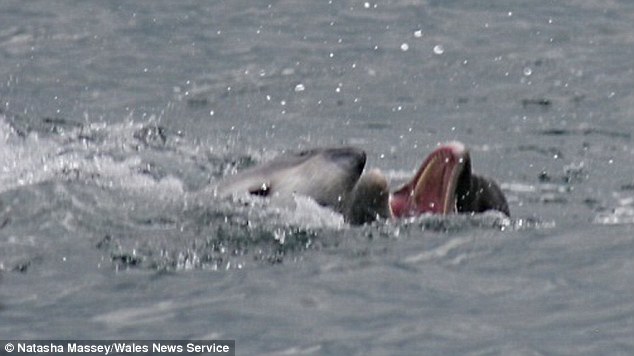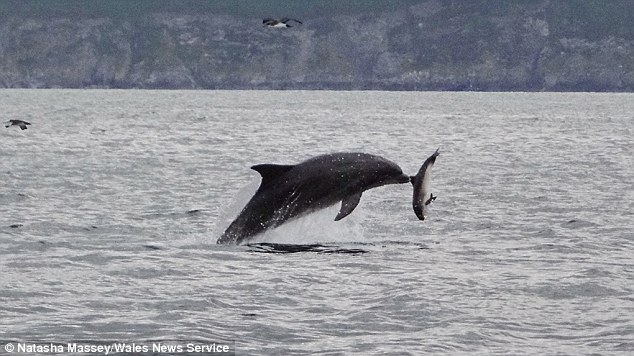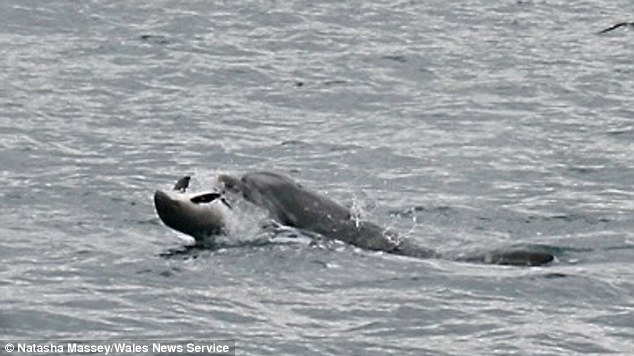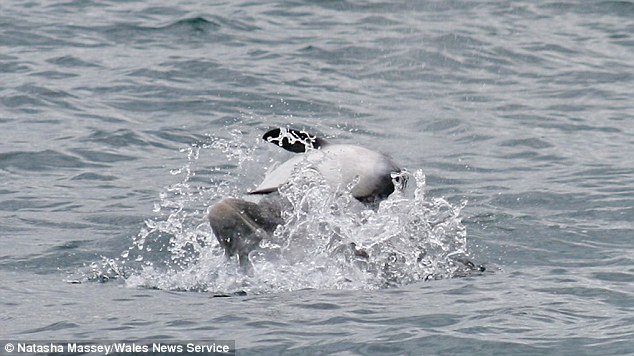
Marine scientists are struggling to understand why the rare attacks have been on the rise - with three out of the four attacks proving fatal. Researchers at the Cardigan Bay Marine Wildlife Centre (CBMWC) said they have always known dolphins attack porpoises, but that the frequency of recent attacks is alarming.
Volunteers at CBMWC, in Ceredigion, West Wales, rescued a porpoise stranded on the beach in May after being chased by dolphins. Last month researchers witnessed three dolphins killing a porpoise - with another fatal attack a week later. Then last week three dolphins spent 20 minutes brutally attacking a porpoise close to the centre's research vessel.
The bottlenose dolphins repeatedly pounced on the porpoise, forcing it underwater then throwing it in the air close to the boat. 'One of the dolphins in particular was attacking the porpoise while the others joined in from time to time,' said researcher Milly Metcalfe. 'Although we were close by, they took no notice of us, intent on the attack.'
The crew pulled the porpoise's battered body on board their research vessel and found blood coming from its mouth - suggesting it may have had punctured lungs or other internal injuries.
Cardigan Bay is home to Europe's largest resident population of dolphins - who share the sheltered waters with smaller harbour porpoises.


'One possibility is that they see the porpoises as competitors for food, especially if there's a shortage of prey in the area,' she said.
'Although porpoises normally go for smaller prey, dolphins will eat anything.
'However there's been no other indication recently of any shortage.'
Another theory is that a low number of females is prompting the attacks by males.
Male dolphins have been known to kill young dolphins in order to mate with the calf's mother. Porpoises are similar in size to a dolphin calf.
The centre said it is unclear which dolphins have been responsible for the attacks.
Ms Perry added: 'One animal we're familiar with, Nick, a female, was seen in the area when we rescued the porpoise last month, and she was also seen nearby in last week's attack.
'Our records show that she's been seen before with the animals we think were responsible for the attack, so it may even be that she's teaching the others.'

THE HARBOUR PORPOISE
The harbour porpoise (Phocoena phocoena), which has been the subject of the dolphin attacks, is one of six species of porpoise.
It is one of the smallest marine mammals and typically stays close to the coast or in river estuaries.
The creature gets its name from Medieval Latin poropiscus, which means pig fish.
Harbour porpoises have been known to dive 720 feet (220 metres) and can hold their breath for up to five minutes.
Up until 2008, scientists were baffled about why quite large numbers of the small marine mammals were found dead - and the U.S. navy was even blamed for scores of dead porpoises in Virginia.
But then tell-tale teeth marks were identified and examinations of the harbour porpoises' bodies revealed broken ribs, imploding lungs and internal bleeding, from prolonged dolphin attacks, The Telegraph reported.
Most cases of the attacks have been documented along the east coast of Scotland and off the coast of Virginia.



In 2010 BP unleashed a WMD in the Gulf of Mexico. Both areas are spots the water naturally takes, flowing from the gulf, along the Atlantic seaboard and over to the isles. Perhaps it's some effect of all that oil and all that Corexit, "Thanks Al Gore!"